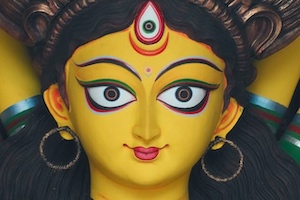From sultan’s court to modern Bengal: Enduring story of Durga worship
The Statesman | 22 September 2025As Bengal readies itself for the descent of Ma Durga — the Mother, the Daughter, the timeless force of Shakti — stories resurface from twilight memories. Stories that reveal how the Goddess transcended man-made borders and how, in Her worship, the possibility of unity and harmony shone bright. Two Pujas, rooted in Bangladesh and now thriving in Krishnagar, carry this legacy across time and space. Their history is not just about ritual; it is about community, inclusivity, and the strength that lies in shared faith.
Basu Bari Durga Puja: Where tradition meets reform
The Basu Bari Durga Puja has its beginnings in a courtly past. Gopinath Basu, wazir under Sultan Alauddin Hussain Shah (1493–1519), was honoured with the title Purender Khan for his administrative prowess. Yet, the family retained its Hindu identity even while accepting the distinction bestowed by a Muslim ruler.
From this lineage emerged Maladhar Basu, later hailed as Gunadhar Khan, whose devotional verses in Srikrishnavijaya Kabbo so touched Sri Chaitanya Mahaprabhu that they found mention in Chaitanya Charitamrita. In those times, art transcended doctrine; a Muslim Sultan could attend a Hindu kabbogeeti as easily as he offered his namaz.
As centuries unfolded, the Basu family turned their devotion to Shakti. From Mahingarh to Chouberia in Faridpur, their Durga Puja became the heart of agrarian community life. When economic compulsions drew Sanat Kumar Basu to Krishnagar in 1970, the family carried with them their ancestral Durga dalan frame, rebuilding in West Bengal what had once stood in Bangladesh.
Sanat Kumar Basu, meticulous and steadfast, upheld tradition. But his son, the late Salil Kumar Basu, civil engineer and Jadavpur gold medallist, combined science with sensitivity. Deeply attached to custom yet unwilling to ignore compassion, he ended the practice of pantha-boli (goat sacrifice), giving the Puja a humane, modern spirit. Today, it is his wife, Shrimati Ratna Basu, and son, Satyaki, who carry the torch — with the Goddess presiding not merely as an idol but as the epicentre of an extended, inclusive family.
Hazra Bari Durga Puja: A legacy of shotruboli
The Hazra family’s Puja, too, traces its roots to Bangladesh. Zamindar Apurboshree Hazra of Dhaka, honoured by the Nawab for sending a thousand soldiers (hazar), laid its foundation centuries ago. The annual Puja coincided with the harvest of new rice, its offerings drawn straight from the soil.
But political turbulence and the rising communal tempers of the twentieth century forced the Hazras to move across the border. They carried with them ornaments of the Goddess, remnants of a shared home. For decades, the Puja was celebrated on both sides of the frontier, in Dhaka’s Armenitola Street and in West Bengal. By 1999, as Bangladesh’s climate grew less favourable to such festivities, the family’s Durga finally settled in Nagendranagar, Krishnagar.
Here, one ritual stands out — Shotruboli. In this symbolic act, a doll made of rice paste is ceremonially decapitated by male members of the family. The enemy it represents is not human but the inner demons of envy, sloth, and negativity. The rite, profound in its allegory, reaffirms that Durga’s victory lies not only in slaying the external Asura but also the failings within.
Shakti in Unity
In both the Basu and Hazra households, Durga’s presence is not confined to the idol. She is alive in the dhaakis whose rhythms electrify the air, in the paal sculptors who mould clay into divinity, in the flower sellers, sweetmeat vendors, and priests who weave themselves into the five-day carnival. For every devotee, the experience of Shakti is collective — an affirmation of strength that arises from togetherness.
These Pujas are more than rituals transported across borders. They are living narratives of resilience, inclusivity, and adaptation. Like rivers meandering yet finding new homes, the traditions have flowed from Bangladesh into Bengal, carried by faith and nurtured by memory.
And as the Goddess rises, resplendent in her golden hues, old songs return to memory — songs of harmony that once bridged religions and borders. The words of Shah Abdul Karim echo once more: “Aage ki shundor din kataitam…” The days may have changed, but the hope of reclaiming that harmony remains. For in every beat of the dhak, every chant of ma go, lies the dream of a society where the many sing the same song together.
